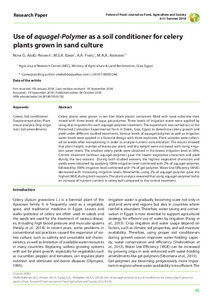Aufsatz

Use of aquagel-Polymer as a soil conditioner for celery plants grown in sand culture
Zusammenfassung
Celery plants were grown in ten liter black plastic containers filled with sand substrate then mixed with three levels of aqua gel-polymer. Three levels of irrigation water were applied by using drip irrigation for each aquagel-polymer treatment. The experiment was carried out at the Protected Cultivation Experimental Farm in Dokki, Giza, Egypt to determine celery growth and yield under different studied treatments. Various levels of aquagel-polymer as well as irrigation water levels were applied in a factorial design with three replicates. Plant samples were collected six weeks after transplanting in order to analyze nutrient concentration. The results showed that plant height, number of leaves per plant, and dry weight were increased with rising irrigation water levels. The smallest celery yields were obtained in the lowest irrigation level at 50%. Control treatment (without aquagel-polymer) gave the lowest vegetative characters and yield during the two seasons. During both studied seasons, the highest vegetative characters and yields were obtained by applying 100% irrigation level combined with 2% of aquagel-polymer, followed by 100% irrigation level combined with 1% of gel-polymer. Water Use Efficiency (WUE) decreased with increasing irrigation levels. Meanwhile, using 2% of aquagel-polymer gave the highest WUE during both seasons. The plant analysis revealed that using aquagel-polymer led to an increase of nutrient content in celery leaf compared to the control treatment.
Zitierform
In: Future of Food: Journal on Food, Agriculture and Society. Witzenhausen : University of Kassel, Specialized Partnerships in Sustainable Food Systems and Food Sovereignty. - Vol. 6, No. 1 (2018), S. 85-94Sammlung(en)
Vol 06, No 1 (2018) (Future of Food: Journal on Food, Agriculture & Society // The Future of Food Journal: Journal on Food, Agriculture & Society)Zitieren
@article{urn:nbn:de:hebis:34-2018070355792,
author={AbdEl-Rahman, Noha G. and Emam, M.S.A. and Farag, Ahmed Awny and Abdrabbo, Mohamed Ahmed A.},
title={Use of aquagel-Polymer as a soil conditioner for celery plants grown in sand culture},
year={2018}
}
0500 Oax 0501 Text $btxt$2rdacontent 0502 Computermedien $bc$2rdacarrier 1100 2018$n2018 1500 1/eng 2050 ##0##urn:nbn:de:hebis:34-2018070355792 3000 AbdEl-Rahman, Noha G. 3010 Emam, M.S.A. 3010 Farag, Ahmed Awny 3010 Abdrabbo, Mohamed Ahmed A. 4000 Use of aquagel-Polymer as a soil conditioner for celery plants grown in sand culture / AbdEl-Rahman, Noha G. 4030 4060 Online-Ressource 4085 ##0##=u http://nbn-resolving.de/urn:nbn:de:hebis:34-2018070355792=x R 4204 \$dAufsatz 4170 7136 ##0##urn:nbn:de:hebis:34-2018070355792
<resource xsi:schemaLocation="http://datacite.org/schema/kernel-2.2 http://schema.datacite.org/meta/kernel-2.2/metadata.xsd"> 2018-10-16T13:03:12Z 2018-10-16T13:03:12Z 2018-10-09 2197-411X urn:nbn:de:hebis:34-2018070355792 http://hdl.handle.net/123456789/2018070355792 eng Section Specialized Partnerships in Sustainable Food Systems and Food Sovereignty at the University of Kassel, Germany and Federation of German Scientists (VDW) Urheberrechtlich geschützt https://rightsstatements.org/page/InC/1.0/ Celery Soil conditioner Evapotranspiration Plant tissue analysis Drip irrigation Soil amendments 630 Use of aquagel-Polymer as a soil conditioner for celery plants grown in sand culture Aufsatz Celery plants were grown in ten liter black plastic containers filled with sand substrate then mixed with three levels of aqua gel-polymer. Three levels of irrigation water were applied by using drip irrigation for each aquagel-polymer treatment. The experiment was carried out at the Protected Cultivation Experimental Farm in Dokki, Giza, Egypt to determine celery growth and yield under different studied treatments. Various levels of aquagel-polymer as well as irrigation water levels were applied in a factorial design with three replicates. Plant samples were collected six weeks after transplanting in order to analyze nutrient concentration. The results showed that plant height, number of leaves per plant, and dry weight were increased with rising irrigation water levels. The smallest celery yields were obtained in the lowest irrigation level at 50%. Control treatment (without aquagel-polymer) gave the lowest vegetative characters and yield during the two seasons. During both studied seasons, the highest vegetative characters and yields were obtained by applying 100% irrigation level combined with 2% of aquagel-polymer, followed by 100% irrigation level combined with 1% of gel-polymer. Water Use Efficiency (WUE) decreased with increasing irrigation levels. Meanwhile, using 2% of aquagel-polymer gave the highest WUE during both seasons. The plant analysis revealed that using aquagel-polymer led to an increase of nutrient content in celery leaf compared to the control treatment. open access In: Future of Food: Journal on Food, Agriculture and Society. Witzenhausen : University of Kassel, Specialized Partnerships in Sustainable Food Systems and Food Sovereignty. - Vol. 6, No. 1 (2018), S. 85-94 AbdEl-Rahman, Noha G. Emam, M.S.A. Farag, Ahmed Awny Abdrabbo, Mohamed Ahmed A. </resource>
Die folgenden Lizenzbestimmungen sind mit dieser Ressource verbunden:
Urheberrechtlich geschützt

